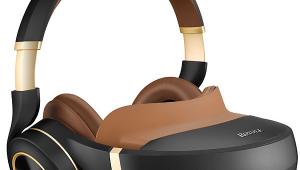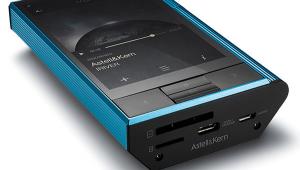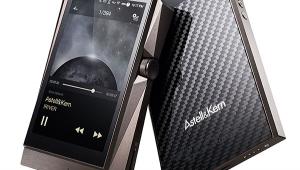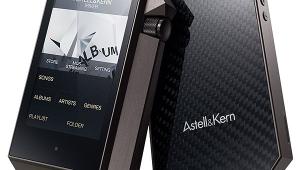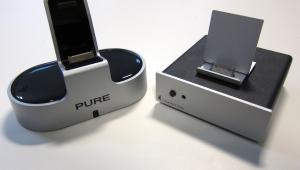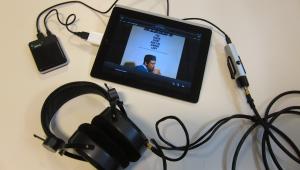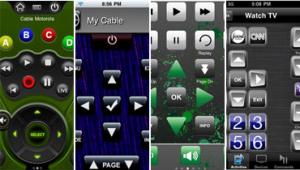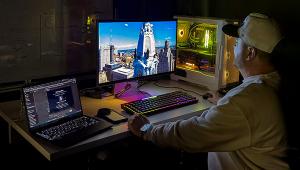Review: The Best iPhone Universal Remote Apps Page 4
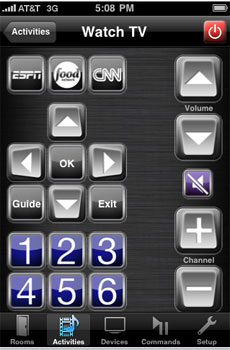 RedEye
RedEye
RedEye, which hails from developer ThinkFlood (what, is everybody’s spacebar broken?), takes a very different approach from our other three iMote solutions. Instead of locating the requisite IR transmitter at the iPhone’s dock connector in the form of a plug-in dongle, RedEye places it in a stationary tabletop base station that also doubles as an iPhone charging stand. This integrates an IR “blaster” array of infrared LEDs that are intended to flood your equipment rack with the signals needed to place them under your sway. (It’s also the reason why the RedEye costs more than twice as much as the others.)
This clever solution has a number of huge advantages, which I’ll get to in a moment, as well as two potential disadvantages. First, the RedEye base station must be within clear line-of-sight of all components it needs to operate. Thus, if your equipment is in one corner some 90° from the TV and shadowed by a potted rubber tree, you’ll have to find a location for the RedEye base that splits the angle effectively. Given the base’s essentially 360° coverage, this turned out to be fairly easy in my case (even though my TV is indeed 90° from my gear rack); I simply placed the base on a shelf over my desk where it sat at a 45° angle from both the TV and the rack. In cases where coverage is problematic or your gear lives behind opaque doors, RedEye recommends running secondary, wired IR flashers from the IR repeater jacks on an A/V receiver or preamp/processor. (I should note: the RedEye hardware does not incorporate any IR repeater facilities.)
The second potential drawback is that RedEye works only on the system where the base lives. Unlike with the other iMotes, you can’t carry a dongle in your pocket and use it to control your upstairs system at bedtime, or down at the pub to secretly change the channel from ESPN to Bravo. (Wear running shoes if you decide to try this at my local joint.) But note that ThinkFlood is promising to debut a RedEye Mini (at less than $50), which will use a dongle — though this one plugs into the iPhone’s headphone jack, not the dock connector.
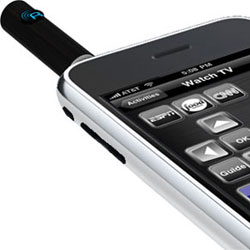
Now to the base-station pluses. The lack of a dongle means there’s nothing to plug, unplug, or lose. The iPhone communicates with the RedEye base via your home’s Wi-Fi network (or, in the absence of one, a dedicated “RedEye network” that the base station creates), which also means you don’t have to aim the iPhone toward the component under control, or in any particular direction at all. And for a multiroom system, you can purchase additional base stations and use your iPhone(s) to serve as remote- room controllers (assuming Wi-Fi coverage).
Setting up RedEye begins with plugging in the base and establishing a network. Next comes software setup of the Red- Eye app on the iPhone. Like Re, RedEye employs metaphors of Rooms and Activities to organize commands. Unlike Re and the other iMotes, it does not incorporate its full IR command database within the app, but instead downloads code sets “from the cloud” as you identify your brands and models during setup. This can take a minute or two for complex components such as an A/V receiver, but it presumably makes the app smaller and more responsive. (It also should permit ThinkFlood to keep its code sets current without having to release frequent updates to the downloadable app.)
And indeed, RedEye’s code sets proved to be comprehensive and well targeted. (In many cases, RedEye uses a specific device model number to select the correct set.) Of course, it’s the Activities pages where Think- Flood’s system really shows its stuff. RedEye automatically offers up common sets like “Watch TV.” Once you identify which components would be involved (in my case, TV, A/V receiver, and cable box), the app proposes a basic command set, complete with buttons, layout, and selfactuating Launch and Shutdown routines.
These “templates” proved fallible. “Watch TV,” for instance, lacked commands to select the proper inputs on receiver and TV (RedEye has no way of knowing what you have plugged into what, or via which input), but adding these and ordering them into the Launch macros was quick and easy, and involved just navigating a few levels of setup menus to choose from the device commands that had already been loaded.
Since RedEye is a “state-aware” system, it’s smart enough that when you change activities — say, from “Watch TV” to “Listen to Radio” — it won’t turn components off just to turn them immediately back on, to cite one example. And creating an entirely new activity of your own devising, combining whatever set of components and commands you desire, is only a little more arduous. Similarly, learning IR commands (from original remotes) to fill blanks in a command set, or to create an entire new one for a component absent from ThinkFlood’s listings, was easy and well prompted by the app — though you must aim the original remote not at the iPhone but at the RedEye base station while teaching. Finally, ThinkFlood has also made a creative attempt to improve upon the main weakness of all touchscreen controllers: the near impossibility of no-look operation. RedEye lets you link up to 24 buttons to the 24 iPhone physical “gestures.” These include gaming-style accelerometer moves such as shake and flick-left, plus various trackpadlike finger moves like swipe, double taps with two and three fingers, and so on. With practice these worked as advertised, though I had a certain amount of trouble. (The fault may well lie with the operator and not the system.)
$188, Thinkflood.com
- Log in or register to post comments
